Moto X Review
by Brian Klug on August 26, 2013 1:30 PM EST- Posted in
- Smartphones
- Qualcomm
- MSM8960
- Motorola
- Android
- Mobile
- Android 4.2
- Moto X
Internal Storage Performance
by Anand Shimpi
Stock Android deployments use ext4 formatted partitions for OS and user data. The Moto X’s pseudo-stock Android 4.2.2 uses ext4 for all partitions with the exception of user data storage, which uses F2FS (Flash Friendly File System):
/dev/block/platform/msm_sdcc.1/by-name/system /system ext4
/dev/block/platform/msm_sdcc.1/by-name/fsg /fsg ext4
/dev/block/platform/msm_sdcc.1/by-name/customize /customize ext4
/dev/block/platform/msm_sdcc.1/by-name/modem /firmware ext4
/dev/block/platform/msm_sdcc.1/by-name/userdata /data f2fs
/dev/block/platform/msm_sdcc.1/by-name/cache /cache ext4
/dev/block/platform/msm_sdcc.1/by-name/persist /persist ext4
/dev/block/platform/msm_sdcc.1/by-name/pds /pds ext3
/sys/kernel/debug /sys/kernel/debug debugfs
/dev/block/platform/msm_sdcc.1/by-name/userdata /mnt/shell/emulated f2fs
/dev/block/platform/msm_sdcc.1/by-name/userdata /storage/emulated/legacy f2fs
/dev/block/dm-0 /mnt/asec/com.cgollner.systemmonitor-1 ext4
As its name implies, F2FS is designed to be better optimized for use on NAND flash based storage - like the integrated eMMC solution used in the Moto X.
Unlike ext4, F2FS is a log-structured file system. A log-structured file system mixes data and log writes together in an attempt to serialize all writes. Ext4, by comparison, is a journaling file system that keeps track of all file system changes in a journal. A centrally located journal basically means all writes end up looking pseudo-random from the perspective of the storage device, since all writes involve writing the actual data as well as updating the journal located somewhere else in storage space. Log-structured file systems attempt to write both data and file system updates sequentially, as a circular log.
The serialization of writes alone is enough to seriously improve performance (look at the ratio of sequential to random write performance on solid state storage), but F2FS also includes some other features that make it very flash friendly. At a high level, F2FS seems to implement many of the same architectural features we see within solid state drives. As long as there’s enough free space, all new writes happen to empty blocks rather than previously used addresses (as a result, real time garbage collection is necessary). There are even similarities down to the underlying organizational structure of F2FS partitions and SSDs, with counterparts existing for flash pages, blocks and planes. Wear leveling obviously isn’t a concern of F2FS, but largely mirroring what happens internally to the eMMC/SSD definitely helps keep performance high. There’s also apparently some file system/storage hardware awareness baked into F2FS as well. TRIM is not only supported, but it appears to be supported on file delete rather than operating as an idle time task as in Android 4.3 with fstrim.
The Moto X uses F2FS on user data partitions, which has tremendous impacts not only on performance but device behavior over time. For starters, the Moto X boasts better random write performance than any other Android device we’ve ever tested:
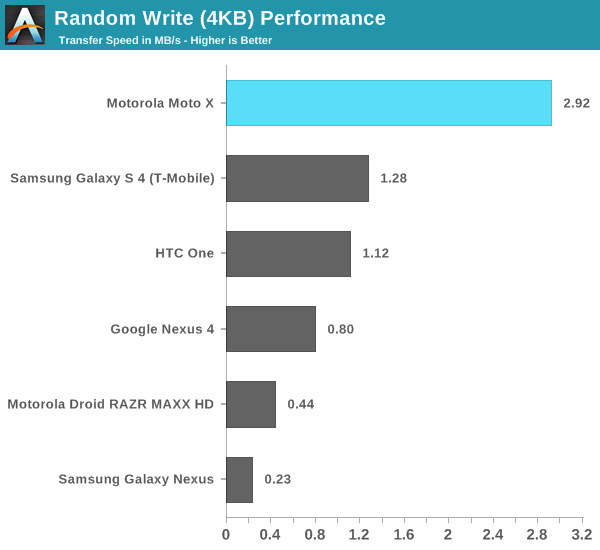
My guess is the advantage we’re seeing here has more to do with F2FS serializing log updates rather than Motorola simply implementing better eMMC hardware, although that is still possible as well.
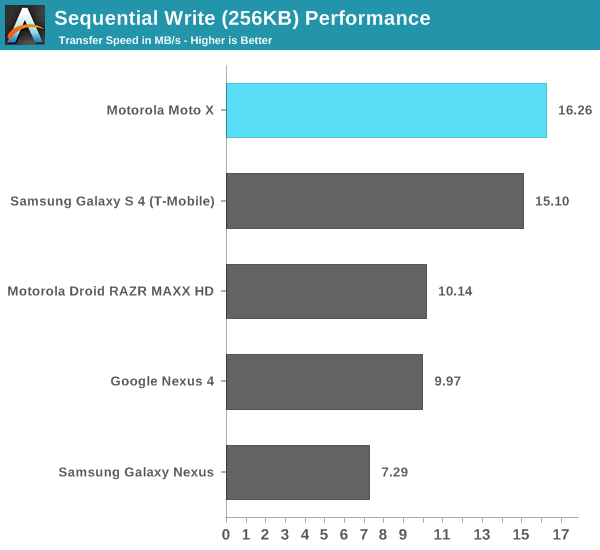
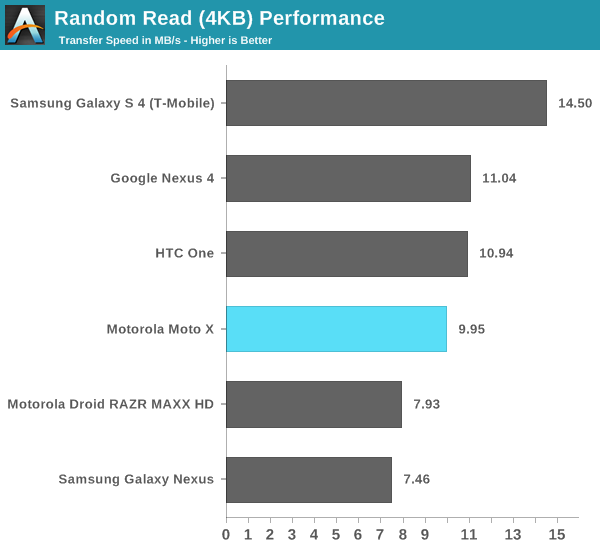
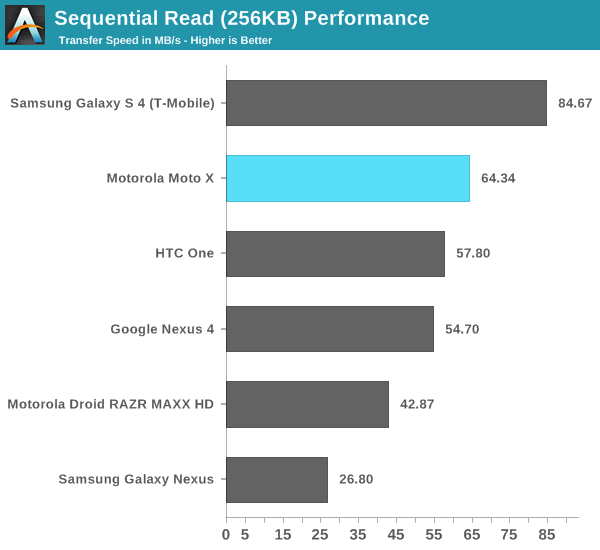
Sequential speeds are competitive, although random read performance is a bit lower than on the Galaxy S 4. Between Brian’s two review units we have seen the performance of both SanDisk and Toshiba eMMC devices in the Moto X:
| Moto X Storage Performance | ||||||
| Sequential Read | Sequential Write | Random Read | Random Write | |||
| SanDisk 16GB | 64.34 MB/s | 16.26 MB/s | 9.95 MB/s | 2.92 MB/s | ||
| Toshiba 16GB | 64.28 MB/s | 11.48 MB/s | 12.79 MB/s | 2.94 MB/s | ||
Random write performance is near identical, but there are some significant differences in sequential write and random read performance. I've always wondered just how much of a difference exists between various eMMC component suppliers within a given hardware platform, so it's good to have some idea with the Moto X. The Toshiba drive's sequential write performance is substantially less than what SanDisk offers, although random read performance favors the Toshiba solution over SanDisk. I have a hunch that most usage models aren't bound by random read performance, which would make the SanDisk solution the better one, but that's speculation on my part.
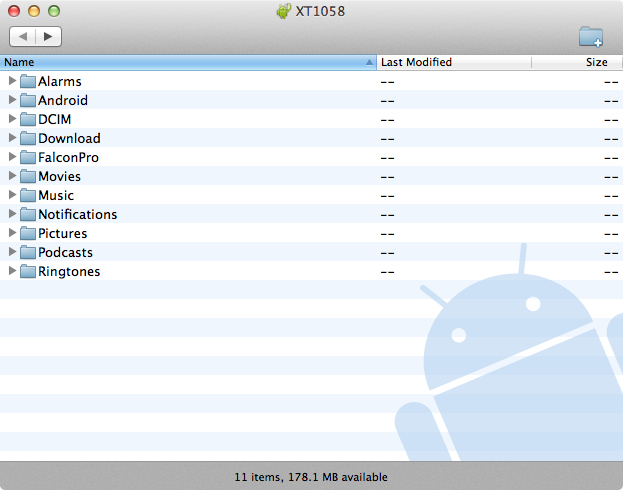
To really stress the eMMC implementation and F2FS, I filled my 16GB Moto X’s roughly 12GB data partition with sequential data. I left less than 200MB free on the device, and then ran our standard 100MB span of read/write tests. This is the same procedure that left the 2013 Nexus 7 with ~0.1MB/s random write speeds, but in the case of the Moto X we saw a small but nowhere-near-as-bad performance degradation:
| Moto X Storage Performance | ||||||
| Sequential Read | Sequential Write | Random Read | Random Write | |||
| New Condition | 61.99 MB/s | 11.49 MB/s | 12.90 MB/s | 3.17 MB/s | ||
| 1st Run After Fill | 60.52 MB/s | 9.42 MB/s | 13.33 MB/s | 2.38 MB/s | ||
| 2nd Run After Fill | 62.54 MB/s | 10.24 MB/s | 13.05 MB/s | 2.43 MB/s | ||
| 3rd Run After Fill | 62.00 MB/s | 10.42 MB/s | 13.38 MB/s | 2.24 MB/s | ||
| 4th Run After Fill | 61.90 MB/s | 10.12 MB/s | 13.03 MB/s | 2.04 MB/s | ||
| 5th Run After Fill | 61.16 MB/s | 10.01 MB/s | 12.92 MB/s | 2.40 MB/s | ||
At worst I saw a 50% decrease in random write performance, while still delivering an order of magnitude better performance than the worst case on a 2013 Nexus 7. The combination of eMMC hardware and F2FS appears to give the Moto X relative immunity to the sort of significant slowdowns we’ve seen with other Android eMMC implementations. In other words, based on this data, you could run your Moto X at or near full capacity without significantly compromising user experience.
It gets even better.
I then deleted all of the files I wrote to the F2FS partition to find out if I’d see an immediate improvement in performance. I did:
| Moto X Storage Performance | ||||||
| Sequential Read | Sequential Write | Random Read | Random Write | |||
| New Condition | 61.99 MB/s | 11.49 MB/s | 12.90 MB/s | 3.17 MB/s | ||
| 1st Run After Fill | 60.52 MB/s | 9.42 MB/s | 13.33 MB/s | 2.38 MB/s | ||
| 2nd Run After Fill | 62.54 MB/s | 10.24 MB/s | 13.05 MB/s | 2.43 MB/s | ||
| 3rd Run After Fill | 62.00 MB/s | 10.42 MB/s | 13.38 MB/s | 2.24 MB/s | ||
| 4th Run After Fill | 61.90 MB/s | 10.12 MB/s | 13.03 MB/s | 2.04 MB/s | ||
| 5th Run After Fill | 61.16 MB/s | 10.01 MB/s | 12.92 MB/s | 2.40 MB/s | ||
|
||||||
| 1st Run After Delete | 61.69 MB/s | 12.08 MB/s | 12.98 MB/s | 3.62 MB/s | ||
| 2nd Run After Delete | 61.90 MB/s | 12.06 MB/s | 12.56 MB/s | 3.96 MB/s | ||
| 3rd Run After Delete | 62.26 MB/s | 11.98 MB/s | 12.93 MB/s | 3.95 MB/s | ||
I waited a few seconds after deleting the ~10GB of data I wrote to the drive before running our storage tests. Apparently that wasn’t long enough as there was a several second pause while writing my 100MB test area to the eMMC device. I suspect the eMMC was still TRIMing the recently freed blocks, causing the pause. Once the test started running however, performance shot up past my first run on the Moto X.
It seems like the Moto X implements TRIM on delete, at least on the F2FS partition. My guess is that TRIM on delete is fairly easy to implement with F2FS given the file system’s SSD-like garbage collection.
Motorola’s decision to include F2FS on the Moto X appears to be a great one from a performance standpoint. The Moto X is the first Android device I’ve used that should be able to keep its performance relatively high while operating in a (nearly) full partition state.
F2FS seems to mirror a lot of the fundamental architecture decisions of high-end SSDs, but at the file system level in software. As eMMC controllers tend to be fairly limited in performance, and eMMC firmware architectures are equally disappointing, leveraging the host OS to do things a little better makes a lot of sense. For the past couple of years I’ve been wondering what the path will be to improve storage performance in mobile devices. I’d previously assumed that we would simply see steady increases in storage performance/complexity, but perhaps we’ll instead see the burden shared by both mobile hardware and the underlying OS/file system.
What are the downsides to F2FS? The big one for me is that I don’t have much experience with the file system. There are always concerns about doing something different, particularly when it comes to trying new file systems on user data. Keep in mind, none of my analysis here has anything to do with reliability or the ability of F2FS to maintain data integrity.











105 Comments
View All Comments
SomeGuyonaBike - Tuesday, August 27, 2013 - link
I understand and agree with general objections to carrier-installed bloatware (and because of this I won't decide whether or not to buy a carrier-branded X until details about the developer editions are public)... I'm just curious as to why reviewers are so negative about this particular piece of carrier bloat.Impulses - Tuesday, August 27, 2013 - link
I think I disabled it on my sister's One X, wasn't really an issue...SomeGuyonaBike - Tuesday, August 27, 2013 - link
I spent a few minutes playing with a demo unit at an AT&T store over the weekend. When I launched the "People" app it wanted to sync to an AT&T address book, but there was an option to decline. I wonder if opting out of using the AT&T address book is a permanent thing, or if you have to repeat the opt-out every so often.Tralio - Wednesday, September 11, 2013 - link
AT&T address book is a bit of an annoyance for everyday use, even on the X it tends to open incredibly slow. On the other hand when switching to my X it imported all my contacts onto my device without needing to import from sim. This can be an issue when switching from some of motorola or other developers' older models with larger sims, especially with the X not having an sd card slot and not every user knowing they can import/export from their comp. On a side note though for at&t users (not sure about the rest of the carriers) all at&t stores have a sim cutter that they can cut your sim down to the smaller size if you'd prefer to import from your current sim card or just don't want to deal with activating the new one.jasperjones - Monday, August 26, 2013 - link
Brian,I agree that smartphone line out/headphone out sound quality is still a bit of a challenge. Looking forward to your new audio test suite. It would be great if you guys could report RMAA results.
Brian Klug - Monday, August 26, 2013 - link
I like RMAA, but it's easy to get a lot of things wrong and isn't really mobile workflow friendly. We're going to try something different that's a lot more robust :)-Brian
synaesthetic - Friday, September 6, 2013 - link
The thing I would like most, that I can't seem to find anywhere for any smartphone, and something that affects audio quality with headphones to a greater degree than any other attribute...Output impedance.
Please, for the love of all that is holy, why can't at least one device reviewer measure the output impedance of these phones?!
cheinonen - Monday, August 26, 2013 - link
I should find out this week if I'll have access to a new suite of tests or not. If I can do it, RMAA will look like child's play in comparison. Believe me, we're looking forward to it.Impulses - Tuesday, August 27, 2013 - link
Are you gonna go back and test at least this year's flagships? It'd be nice to have a baseline, particularly since this is something manufacturers have supposedly emphasized (HTC with the One, LG with the upcoming G2).cheinonen - Tuesday, August 27, 2013 - link
It looks like I'll have access to some new testing methods, but it will be a month or so until I can do them all probably (sorry, I have a large backlog of other things to get done right now). I'll plan to do a huge initial round-up of phones and tablets to get a baseline and create an article about the new tests. I also want to point out that audio tests might not run with the initial phone tests since Brian or anyone else will have to ship the phones to me in Oregon to test and it'll take them out of the hands for a few days.We haven't tested this yet, but we're hoping it really helps us set a standard for audio testing of phones and tablets.